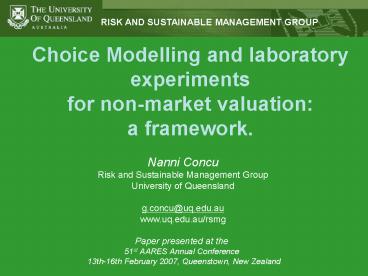Choice Modelling and laboratory experiments - PowerPoint PPT Presentation
1 / 17
Title:
Choice Modelling and laboratory experiments
Description:
RISK AND SUSTAINABLE MANAGEMENT GROUP. Choice Modelling and laboratory experiments ... Cumming et al. 1995: hypothetical and real Dichotomous Choices (DC) ... – PowerPoint PPT presentation
Number of Views:37
Avg rating:3.0/5.0
Title: Choice Modelling and laboratory experiments
1
Choice Modelling and laboratory experiments for
non-market valuation a framework.
Nanni Concu Risk and Sustainable Management
Group University of Queensland g.concu_at_uq.edu.au
www.uq.edu.au/rsmg Paper presented at the 51st
AARES Annual Conference 13th-16th February
2007, Queenstown, New Zealand
2
OUTLINE
1. State Preferences (SP) anomalies 2. Data
enrichment and laboratory experiments 3. Recent
Developments 4. Pivot Process and Choice
Modelling 5. Conclusions.
3
1. SP anomalies
- WTP/WTA disparity
- Endowment effect (Tversky and Kahnemann 1991)
- WTP and WTA imply different property right
regimes - WTP/WTA gap questions preference elicitation
techniques
4
1. SP anomalies
2) Scale insensitivity Influence of irrelevant
clues
Use of Heuristics ? (Gigerenzer and Selten 2002)
5
2. Data enrichment and laboratory experiments
- Data enrichment (Adamowicz et al. 1994)
- Revealed Preference (RP) and SP data contain a
similar preference structure - Variance of SP estimates larger than RP
6
2. Data enrichment and laboratory experiments
- Laboratory experiments
- Direct revelation mechanisms
- Truth-telling is the dominant strategy
- Cumming et al. 1995 hypothetical and real
Dichotomous Choices (DC) - Balistreri et al (2001) Hypothetical and real
DC and Open-ended (OE) - Veisten Navrud (2006) DC, OP and Actual
Payments (AP)
7
3. Recent Developments
Plott and Zeiler (2005) Discovered Preference
Hypothesis Anomalies are errors in stated
preferences that would disappear with learning
- Design strategies
- 1. Incentive compatible mechanism
- 2. Training
- 3. Practice rounds
- 4. Anonymity
- No WTP/WTA gap is observed
8
3. Recent Developments
Healy (2006) Comparison of Direct Revelation
Mechanisms for public good provision
- Voluntary Contribution
- Proportional Tax
- Groves-Ledyard mechanism
- Walker mechanism
- Vickery-Clarke-Grove mechanism (Pivot Process)
Pivot Process most efficient and stable
9
4. Pivot Process and Choice Modelling
Research Agenda
- Integrate Healy and Plott Zeiler (H,PL)
results into CM - Compare CM with PP H,PL
- Calibration of CM estimates
Are there any theoretical and methodological
obstacles?
10
4. Pivot Process and Choice Modelling
Pivot Process main features
- Utility function
- ui(y,xi)v(y) xi
- Strictly concave in y, quasilinear
- Deterministic
11
4. Pivot Process and Choice Modelling
Pivot Process main features
- public good is either provided or not
- private bids (negative or positive)
- public good is provided if positive
bidsgtnegative bids - Each player pays a Clarke tax amount of the bid
that switches the outcome
12
4. Pivot Process and Choice Modelling
Pivot Process main features
13
4. Pivot Process and Choice Modelling
Pivot Process main features
14
4. Pivot Process and Choice Modelling
Choice Modelling main features
- Utility function
- ui(x)V(x) ?
- V(x)?i?iXi
- Linear-in-parameters
- Stochastic
15
4. Pivot Process and Choice Modelling
The way forward reducing the difference between
methods
- Lancasterizing PP model vPP(y)xi V(x)CM
- Randomizing the PP model ui(y,xi)v(y) xi ?
- Impose the same functional form
- Training, practice rounds and anonymity
16
4. Conclusions
- Complementary use of PP and CM
- Insights into hypothetical bias and WTP/WTA gap
- Increase reliability of CM
- Calibration procedure
17
QUESTIONS ?































